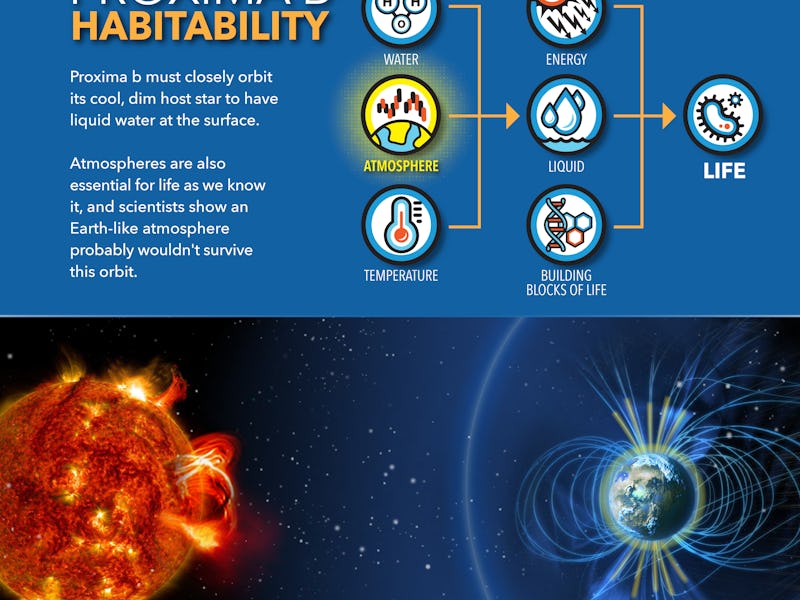Proxima b Probably Isn't Habitable After All, NASA Says

We once had such high hopes for Proxima b. We thought that the Earth-like planet might be covered in a single, giant ocean; that it might be habitable; that it might even currently host life. But a new study from NASA seems to put the final nail in the coffin of those dreams: It suggests that Proxima b is exposed to such strong radiation from its host star, Proxima Centauri, that any habitable atmosphere it might have possessed would have long since been destroyed.
When NASA found Proxima b in August 2016, researchers speculated that the exoplanet might be habitable because it existed within its host star’s “habitable zone,” which encompasses the range of orbits that allow for the atmospheric pressure needed to support liquid water.
Being in this zone doesn’t guarantee that a planet can support life, though. Among other things, it still needs a habitable atmosphere, which NASA defines as one that “allows for climate regulation, the maintenance of a water-friendly surface pressure, shielding from hazardous space weather, and the housing of life’s chemical building blocks.”
To figure out whether Proxima b’s atmosphere fit that highly-specific bill, the agency created a computer model of the planet orbiting Proxima Centauri and substituted Earth’s atmosphere for the unknown atmosphere of Proxima b (since we know that our atmosphere supports life).
An artist imagines the surface of Proxima b.
Unfortunately, the model showed that Proxima Centauri’s intense solar flares and ultraviolet radiation would have already destroyed an Earth-like atmosphere around Proxima b if one ever existed. Proxima b experiences much more extreme radiation than Earth ever does from the sun.
The radiation from Proxima Centauri ionizes gases within Proxima b’s atmosphere, and that process isolates electrons containing enough energy to shoot out of the atmosphere. Because these electrons are negatively charged, they exert a magnetic force upon the positively charged ions and pull those out, too. In the model, both light molecules (ex. hydrogen) and heavy elements (ex. nitrogen and oxygen) slowly leave Proxima b’s atmosphere over time.
The key, then, is how much time. A similar process happens on Earth, but the sun will explode and engulf us before it totally sucks away our atmosphere. Proxima b is less lucky: NASA estimates that the atmospheric destruction on the exoplanet is happening around 10,000 times faster than it is on Earth.
“This was a simple calculation based on average activity from the host star,” Katherine Garcia-Sage, the lead author of the new study, said in the press release. “It doesn’t consider variations like extreme heating in the star’s atmosphere or violent stellar disturbances to the exoplanet’s magnetic field — things we’d expect provide even more ionizing radiation and atmospheric escape.”
A diagram showing Proxima b orbiting Proxima Centauri.
In other words, the research team couldn’t account for every factor that would influence the amount of time it would take Proxima Centauri to destroy Proxima b’s atmosphere. The most conservative estimate is 100 million years, and the most liberal estimate is 2 billion years; either way, such an Earth-like atmosphere around the exoplanet would have long since disappeared, since Proxima b has been around for about 4 billion years.
Small stars like Proxima Centauri, which is a red dwarf, are the most common in the galaxy but are difficult to detect, so scientists often suspect that they are our best hope for finding life.
But after this study, co-author Jeremy Drake is a little less hopeful about the potential for locating life around small red dwarf stars.
“Things can get interesting if an exoplanet holds on to its atmosphere, but Proxima b’s atmospheric loss rates here are so high that habitability is implausible,” he said in the press release. “This questions the habitability of planets around such red dwarfs in general.”